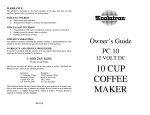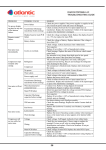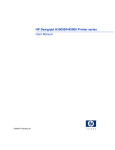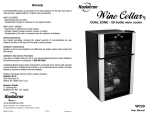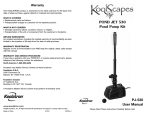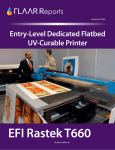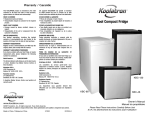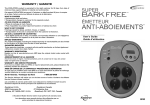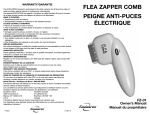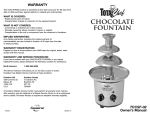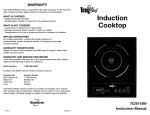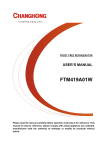Download Chest Freezer
Transcript
Warranty This KOOLATRON product is warranted to the retail consumer for 90 days from date of retail purchase, against defects in material and workmanship. WHAT IS COVERED - Replacement parts and labor. - Transportation charges to customer for the repaired product. Chest Freezer WHAT IS NOT COVERED - Commercial or industrial use of this product. - Damage caused by abuse, accident, misuse, or neglect. - Transportation of the unit or component from the customer to Koolatron. IMPLIED WARRANTIES Any implied warranties, including the implied warranty of merchantability are also limited to duration of 90 days from the date of retail purchase. WARRANTY REGISTRATION Register on-line at www.koolatron.com AND keep the original, dated, sales receipt with this manual. WARRANTY AND SERVICE PROCEDURE If you have a problem with your unit, or you require replacement parts, please telephone the following number for assistance: 1-800-265-8456 A Koolatron Master Service Centre must perform all warranty work. Service after warranty may be obtained at a Master Service Centre or at an authorized service dealer. Purchase Receipt is required to establish warranty eligibility. Koolatron has Master Service Centres at these locations: Koolatron U.S.A. 4330 Commerce Dr. Batavia, NY 14020-4102 U.S.A. Koolatron Canada 27 Catharine Ave. Brantford, ON N3T 1X5 Canada www.koolatron.com ©2009 Koolatron, Inc. All rights reserved. All specification are subject to change without notice. Assembled in Canada KCF51WNG H1S100 09/2009-v1 User Manual SPECIFICATIONS Power Requirements: Capacity: Max. Temp.: Min. Temp.: Weight: AC 120V 60Hz 70W 135.5L (4.8 cu.ft.) -24°C (-11.2°F) at 25°C (77°F) ambient air temp. 0°C (32°F) at 25°C (77°F) ambient air temp. 33 kg (72.8 lbs) SAFETY - Household Use Only. - This unit is an indoor appliance. DO NOT use OUTDOORS. - There must be at least 150 mm (5.9”) clearance around the unit to ensure proper ventilation. - Place unit on a flat surface, away from heat sources. - Do not use the appliance if the plug or cable is damaged. If the power cord is damaged and/or is malfunctioning, please contact the manufacturer. - Pull the plug out of the outlet to disconnect. DO NOT pull the cord. - Do not touch the plug with wet hands. - Never clean appliance parts with flammable fluids. Do not store or use gasoline or any other flammable vapors and liquids in the vicinity of this or any other appliance. The fumes can create a fire hazard or explosion. - Unplug the appliance when not in use. Use of extension cords Because of potential safety hazards under certain conditions, we strongly recommend against the use of an extension cord. However, if you must use an extension cord, it is absolutely necessary that it is a UL-listed (in the United States) or a CSA-listed (in Canada), 3-wire grounding type appliance extension cord having a grounding type plug and outlet and that the electrical rating of the cord is 15 amperes (minimum) and 120 volts. INSTALLATION • Choose a location where there is an electrical outlet within reach of the power cord. There must be at least 150 mm (5.9”) clearance around the unit to ensure proper ventilation. Avoid locations in direct sunlight, moist or extreme cold areas. • Before connecting the appliance to the power source, let it stand upright for approximately 2 hours. This will reduce the possibility of a malfunction in the cooling system from handling during transportation. • Clean the interior surface with lukewarm water using a soft cloth. OPERATING INSTRUCTIONS OPERATING INSTRUCTIONS (cont.) NOTE • Turning the temperature control to "OFF " position stops the cooling cycle but does not shut off the power to the freezer. • If the unit is unplugged, lost power, or turned off; you must wait 3 to 5 minutes before restarting the unit. If you attempt to restart before this time delay, the freezer will not start. • Large amounts of food will lower the cooling efficiency of the appliance. • If you choose to change the thermostat setting, adjust thermostat control by one numerical increment at a time. Allow several hours for temperature to stabilize between adjustments. DEFROSTING YOUR FREEZER • WHEN? For the most efficient operation and minimum energy consumption, defrost the freezer when the frost on the freezer walls is excessive or 5 to 10 mm (0.2” to 0.4”) thick. • Choose a time when the stock of frozen food is low. CAUTION! Do not use boiling water because it may damage the plastic parts. In addition, never use a sharp or metallic instrument to remove frost as it may damage the cooling coils and will void the warranty. We recommend using the plastic scraper provided with your unit. • Remove the frozen food from the freezer and place it in a cooler to protect the food. • Turn the thermostat knob to “OFF”. • Unplug the freezer. The Power Supply light should be off (green light out). • During defrosting, the ice melts into the cabinet. • Remove the drain plug on the inside floor of the freezer by pulling straight out. • Place a shallow pan outside drain outlet. The defrost water will drain out. • Check the pan occasionally so the water does not overflow. • Clean the interior of the freezer. • Replace the plug on the inside floor. • Reset the thermostat to desired setting. • Allow the cabinet to cool for one hour. • Return food to the freezer. HELPFUL HINT Defrosting usually takes a few hours. Leaving the door open will help speed the process. Also, pouring warm water (not boiling) on the ice/frost will help speed melting. If you must use a scraper please use caution - it is very easy to damage the freezer compartment and void your warranty. TEMPERATURE CONTROL • Your freezer has one control for regulating the temperature. The temperature control is located on the lower right hand corner. • The first time you turn the unit on, switch on the Fast Freeze switch and run for at least 2 hours before putting frozen foods inside. This will ensure the cabinet is thoroughly chilled before food is put in. • Turn off the Fast Freeze switch. • The range of the temperature control is from position" 1" the warmest to "6" the coldest. Adjust the temperature control to the setting that best suits your needs. The setting of “4” should be appropriate for home or office freezer use. In the 25°C ambient, the temp for the six position are -4°C,-8°C,-12°C,-16°C,-20°C,-24°C (25°F, 18°F, 11°F, 3°F, -4°F, -11°F). • To turn the freezer off, turn the temperature control to "OFF". THE FREEZER COMPARTMENT • This compartment is designed for the long-term storage of frozen food. Storage time is up to three months. • The storage life of frozen foods varies and the recommended storage time should not be exceeded. The instructions regarding the care of frozen foods should be followed when defrosting the freezer. • Pre-packed commercially frozen food should be stored in accordance with the frozen foods manufacturer’s instructions for a three star frozen food storage compartment or home freezer. • Place frozen food into the freezer as quickly as possible after purchase. If there are instructions on the packet, carefully follow these instructions regarding storage times. • The freezer door is susceptible to breaking due to excessive ice build up. Be sure to defrost when the ice reaches 5 to 10 mm (0.2” to 0.4”) thick. 2 3 THE FREEZER COMPARTMENT (cont.) • A storage basket is provided for the organization of odd-shaped items. To reach other packages in the freezer, just slide the basket to one side, or lift it out. MAINTENANCE CLEANING YOUR FREEZER • Upon installation of your new appliance, it is recommended that it be cleaned thoroughly. • Turn the temperature control to "OFF", unplug the freezer, remove the food and storage basket. • Wash the inside with a damp warm cloth containing a water and baking soda solution. The solution should be about 2 tablespoons of baking soda to a quart of water. • Wash the storage basket with a mild detergent solution. • Be sure to keep the door gasket (seal) clean to keep the unit running efficiently. • The outside of the freezer should be cleaned with mild detergent and warm water. • Dry the interior and exterior with a soft cloth. • The condenser coils should be vacuumed when they are dusty or dirty. • It is recommended that the unit be cleaned each time it is defrosted to help keep the unit odor free and running efficiently. VACATION TIME • Remove all the food. • Unplug the freezer. • Clean the freezer. • Leave the door open slightly to avoid possible formation of condensation, mold, or odors. • Use extreme caution in the case of children. The unit should not be accessible to child’s play. • Short vacations: Leave the freezer operating during vacations of less than three weeks. • Long vacations: If the appliance will not be used for several months, remove all food and unplug the power cord. Clean and dry the interior thoroughly. To prevent odor and mold growth, leave the door open slightly or have the door removed. MOVING YOUR FREEZER • Remove all the food. • Securely tape down all loose items inside your freezer. • Remove the rollers to prevent damage. • Tape the doors shut. • Be sure the freezer stays in the upright position during transportation. ENERGY SAVING TIPS • The freezer should be located in the coolest area of the room, away from heat producing appliances or heating ducts, and out of the direct sunlight. • Let hot foods cool to room temperature before placing in the freezer. Overloading the freezer forces the compressor to run longer. Foods that freeze too slowly may lose quality, or spoil. • Be sure to wrap foods properly, and wipe containers dry before placing them in the freezer. This cuts down on frost build-up inside the freezer. • Freezer storage bin should not be lined with aluminum foil, wax paper, or paper toweling. Liners interfere with cold air circulation, making the freezer less efficient. • Organize and label food to reduce door openings and extended searches. Remove as many items as needed at one time, and close the door as soon as possible. 4 TROUBLESHOOTING GUIDE You can solve many common appliance problems easily, saving you the cost of a possible service call. Try the suggestions below to see if you can solve the problem before calling the servicer. PROBLEM Appliance does not operate. POSSIBLE CAUSE Not plugged in. The circuit breaker tripped or a blown fuse. The freezer temperature control is set at "OFF". Compressor turns on and off The room temperature is hotter than normal. frequently. A large amount of food has been added to the freezer. The door is open too often. The door is not closed completely. The temperature control is not set correctly. The door gasket does not seal properly. The freezer does not have the correct clearances. The freezer has recently been disconnected for a period of time. Four hours are required for the freezer to cool down completely. Temperature inside the freezer Temperature control is set too cold.Turn the control to a warmer is too cold. setting and allow several hours for the temperature to stabilize. Popping or cracking sound Metal parts undergo expansion and contraction, as in hot when compressor comes on. water pipes. This is normal. Sound will level off or disappear as freezer continues to run. Bubbling or gurgling sound, Refrigerant (used to cool freezer) is circulating throughout like water boiling. the system. This is normal. Vibrations. Check to assure that the freezer is level. Floor is uneven or weak. Freezer rocks on the floor when it is moved slightly. Be sure floor can adequately support freezer. Level the freezer by putting wood or metal shims under part of the freezer. The freezer is touching the wall. Re-level the freezer and move it away from the wall. See “Installation Instructions”. Moisture forms on inside Weather is hot and humid, which increases internal rate of freezer walls. frost build-up. This is normal. Door is slightly open. Door is kept open too long, or is opened too frequently. The door is not sealed properly. Moisture forms on outside Door is slightly open, causing cold air from inside the freezer of freezer. to meet warm moist air from outside. The door will not close properly. The appliance is not level. The gasket is dirty. The storage basket is out of position. 5



